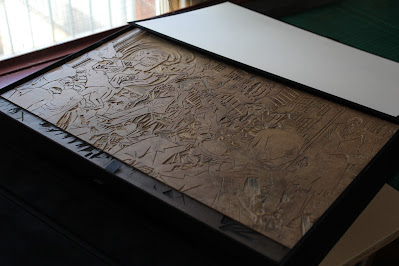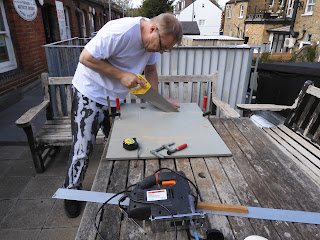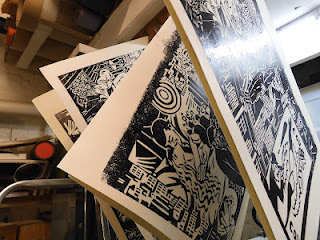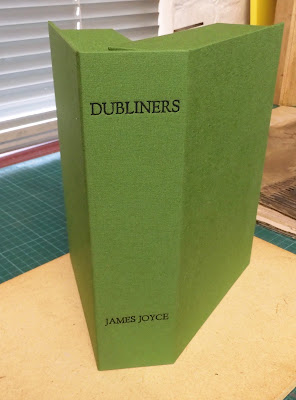Friday, 16 September 2022
Monday, 12 September 2022
Monday Morning... What Could Possibly Go Wrong?
My biblionautic chums and friends.
Ah, Monday morning, what could possibly go wrong?
When the person who borrowed your electric saw "forgets" to tell you that they have broken it when they return it.....
Though I am a little happy that I am still able to saw in a straightish line.
Please note.... there are other studios/binderies doing stuff, spelling and grammar. Please further note, the opinion of the author may change at any moment. This is due to having an open mind of sorts
Thursday, 8 September 2022
La Ville, an abridged story of the binding.
My biblionautic chums and friends.
La Ville... Aa abridged story of the binding.
Frans Masereel (31 July 1889 – 3 January 1972) was a Flemish painter and graphic artist who worked mainly in France, known especially for his woodcuts focused on political and social issues, such as war and capitalism. He completed over 40 wordless novels in his career, and among these La Ville is considered to be one of his best.
Masereel's woodcuts influenced Lynd Ward and later graphic artists such as Clifford Harper, Eric Drooker, and Otto Nückel...... and me of course!
The binding of La Ville is a commission from a collector of books, it is always nice to be commissioned to do work by this particular collector as he has a fantastic eye for text blocks that are beautiful, challenging, quirky or fun. La Ville is no exception, the wood-cuts of Masereel are something that one can really get one's teeth into.
Along with the original text block in sheets (more about this later) I was supplied with a reading copy. The reading copy was very cool to have. First I was able to check and correct the pagination of the sheets and use the reading copy as, well, a reading copy. To be able to understand the nature of the 100 images, their relationship within the flow of the pages, to formulate a design.
With La Ville being first published in 1925 it would have been easy to default to and produce a 1920's style binding, perhaps even in the French/Flemish style.
But, and it is a series of big buts...... Masereel's wood cuts are so visceral. By this I mean that there is an earthy feel to the work. The images detail all aspects of urban life, much of it the same now as it was then. From the tenderness of the new-born through to the unreasoning divides in class and culture and the elemental emotions of death and depravity. His work is instinctive and in depth. This I wanted to keep, this was my key to unlock the overall design, look and feel of the book.
But, and it is a series of big buts...... Masereel's wood cuts are so visceral. By this I mean that there is an earthy feel to the work. The images detail all aspects of urban life, much of it the same now as it was then. From the tenderness of the new-born through to the unreasoning divides in class and culture and the elemental emotions of death and depravity. His work is instinctive and in depth. This I wanted to keep, this was my key to unlock the overall design, look and feel of the book.
So.... a slick binding full of colour and gold, inlays and onlays would just not work. The images in the text block are stark and powerful in the simplicity of printing. I kept coming back to black and white, light and shadow. And so began a series of maquettes. A maquette is a scale model or rough draft of an unfinished sculpture and as I have often thought that the book is sculptural in form I tend to use the term maquette.
One of the key aspects I wanted to use was light and shadow/black and white.
First I tried to sculpt the board, creating form with various thicknesses of paper then covering with leather. It just did not have sharpness or clarity that I was looking for. Masereel...
a fantastic wood cut artist.. me not a fantastic wood cut artist.. but I
can do do lino. Perhaps, in hindsight it is an obvious technique for me
to employ but it took time to work towards using lino cuts to get where
I wanted to be.
It became instinctive.. it worked... I was getting there.
As with any research it can take you to places that are perhaps not suitable for the current project but well worth remembering
Once I had sorted out what and how I was going to be working, the technique at least I turned my attention to the text block. As mentioned before, it was in sheets. many sheets. Basically a series of folios, simply the paper folded with two prints on each folio...
Easy for the printer... a nightmare for the binder. To sew each section would have been so difficult, the swell not easy to manage. In addition, to compound the problems no two folios were the same size. Some with the deckle edge to either the head or the tail.. some with no deckle...all over the place.
Having worked with art printers I had a solution, simple, strong and workable. Basically to join three folios together with a Kozo (Japanese paper) hinge and sew through the center folio.
Now that the construction of the text blocked had been sorted out I turned my attention to the end papers. This time the choice of medium was easy... yep... lino cut.
My aim was to produce a montage of abstracted Masereel prints for each end paper and doubler. Slowly building up the image as I worked. Taking rubbings as I worked the lino to ensure that all was ok.
With the leather ordered from Harmatan https://www.harmatan.co.uk/ (my go to leather people, in fact I have been using their leathers since I was at college more than 30 years ago... please note other tanners are available) and all the componets in place work could bein in bringing all together. The decision was made to trim the sections, taking minimum of to neaten the text block up. Not an easy choice to make but because of the nature of the unevenness of the sections it was the practical thing to do. Sewing, rounding and backing, end bands and all the other little steps that make up the journey of the making of a book commenced.
The leather was worked during the covering process, the play of light and shadow more than evident form the first. The leather from Harmatan was a joy to work with, having a relationship spanning 30 plus years helps. I know their products, they know what I am looking for when I describe the effect I am after and I always consider them to be part of the binding team. As indeed I do my other suppliers such as John Purcell Papers https://www.johnpurcell.net/ again the staff have knowledge of the papers, boards etc they have. They care and understand they don't just sell. Please note other paper and board suppliers are available.
Finally the binding complete........Light and shadow.
Remember the end papers and doublers? Depending on the angle of light and viewing changes what is and is not seen.
Simple. It would have been easy to go full out and having lashings of gold and inlays and onlays... but why fight the wonderful images? I have taken my inspiration from Masereel's prints. Abstracted and twisted, reformed and re-seen.
Full leather (goat). Hand printed end papers and edge to edge doublers. hand sewn, single needle/minimal end bands etc etc. 286mm x 235mm x 31mm when closed.
Remember the end papers and doublers? Depending on the angle of light and viewing changes what is and is not seen.
Simple. It would have been easy to go full out and having lashings of gold and inlays and onlays... but why fight the wonderful images? I have taken my inspiration from Masereel's prints. Abstracted and twisted, reformed and re-seen.
Full leather (goat). Hand printed end papers and edge to edge doublers. hand sewn, single needle/minimal end bands etc etc. 286mm x 235mm x 31mm when closed.
Please
note.... there are other studios/binderies doing stuff, spelling and
grammar. Please further note, the opinion of the author may change at
any moment. This is due to having an open mind of sorts.
Wednesday, 7 September 2022
La Ville, finished.....
My biblionautic chums and friends.
La Ville... finished. Just the box to make for the book and the lino cuts.
Full leather (goat). Hand printed end papers and edge to edge doublers. hand sewn, single needle/minimal end bands etc etc. 286mm x 235mm x 31mm when closed.
Frans Masereel (31 July 1889 – 3 January 1972) was a Flemish painter and graphic artist who worked mainly in France, known especially for his woodcuts focused on political and social issues, such as war and capitalism. He completed over 40 wordless novels in his career, and among these La Ville is considerd to be one of his best.
Masereel's woodcuts influenced Lynd Ward and later graphic artists such as Clifford Harper, Eric Drooker, and Otto Nückel...... and me of course!
Friday, 2 September 2022
Dubliners, James Joyce and a box.
My biblionautic chums and friends.
Though not a book, box making is part of the job for the bookbinder/book artist.
Boxes for books. First thing to be seen usually the last to be thought about.
Subscribe to:
Posts (Atom)

































